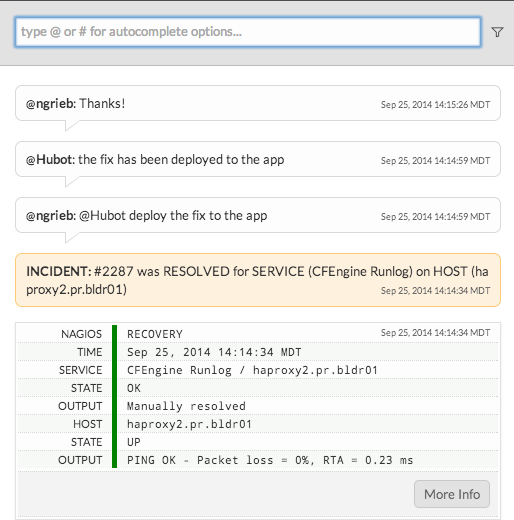Hubot is your company’s robot. Install it in your VictorOps timeline to dramatically improve employee efficiency.
The Hubot – VictorOps Adapter allows your Hubot to join your VictorOps timeline. You can then address Hubot with timeline chat messages in the usual way. After giving your Hubot instance a name (just Hubot in the example below) you can then address it from the timeline with or without an @.

Configuration Steps
- In VictorOps, select Integrations >> Hubot
- If the integration has not yet been enabled, click the “Enable Integration” button to generate your endpoint URL as seen below. Be sure to replace the “$routing_key” section with the actual routing key you intend to use. (To view or configure route keys in VictorOps, click Alert Behavior >> Route Keys)

- If you have not already, install Hubot according to these instructions: https://hubot.github.com/docs/
- Install the VictorOps adapter directly from github:
npm install git://github.com/victorops/hubot-victorops.git - Your Hubot will need a login key to connect to VictorOps. Your Hubot key is available at the “Hubot” link of your VictorOps Integrations page in step 1 above. Configuration of the key is in an environment variable:
export HUBOT_VICTOROPS_KEY=xxxxxxxx-xxxx-xxxx-xxxx-xxxxxxxxxxxx - Add the VictorOps adapter to your Hubot’s dependencies in package.json:
... "dependencies": { "hubot-victorops": ">=0.0.2", ... } ... - Run Hubot with the VictorOps adapter:
bin/hubot --adapter victorops - You may have to remove the empty hubot-scripts.json file, and add a coffee-script dependency. Additionally, you can remove the “hubot-heroku-keepalive” line from both external-scripts.json and dependencies in package.json to avoid an aesthetic error message.
Hubot and the Rules Engine
You can annotate Hubot commands directly to take automated actions.
To accomplish this you will need an additional Hubot script that can be found here.
Then you will need to add an annotation with the name “HUBOT COMMAND” and you will be able to all Hubot programatically.
